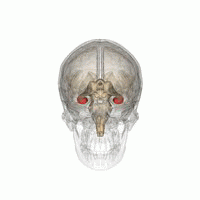
Recurrent connections between CA2 pyramidal cells
Sign Up to like & getrecommendations! Published in 2019 at "Hippocampus"
DOI: 10.1002/hipo.23064
Abstract: Recurrent excitatory synapses have theoretically been shown to play roles in memory storage and associative learning and are well described to occur in the CA3 region of the hippocampus. Here, we report that the CA2… read more here.
Keywords: recurrent excitatory; ca2 pyramidal; region; pyramidal cells ... See more keywords

Hippocampal responses to electrical stimulation of the major input pathways are modulated by dentate spikes
Sign Up to like & getrecommendations! Published in 2022 at "Hippocampus"
DOI: 10.1002/hipo.23470
Abstract: Dentate gyrus (DG) is important for pattern separation and spatial memory, and it is thought to gate information flow to the downstream hippocampal subregions. Dentate spikes (DSs) are high‐amplitude, fast, positive local‐field potential events taking… read more here.
Keywords: input; hippocampal responses; ca3 ca1; stimulation ... See more keywords

Paradoxical hyperexcitability from NaV1.2 sodium channel loss in neocortical pyramidal cells.
Sign Up to like & getrecommendations! Published in 2021 at "Cell reports"
DOI: 10.1016/j.celrep.2021.109483
Abstract: Loss-of-function variants in the gene SCN2A, which encodes the sodium channel NaV1.2, are strongly associated with autism spectrum disorder and intellectual disability. An estimated 20%-30% of children with these variants also suffer from epilepsy, with… read more here.
Keywords: channel loss; sodium channel; pyramidal cells; loss ... See more keywords

Histamine induces KCNQ channel-dependent gamma oscillations in rat hippocampus via activation of the H1 receptor
Sign Up to like & getrecommendations! Published in 2017 at "Neuropharmacology"
DOI: 10.1016/j.neuropharm.2017.03.003
Abstract: ABSTRACT Histamine is an aminergic neurotransmitter, which regulates wakefulness, arousal and attention in the central nervous system. Histamine receptors have been the target of efforts to develop pro‐cognitive drugs to treat disorders such as Alzheimer's… read more here.
Keywords: fast spiking; histamine; pyramidal cells; receptor ... See more keywords

Cannabinoid type 2 receptors mediate a cell type-specific self-inhibition in cortical neurons
Sign Up to like & getrecommendations! Published in 2018 at "Neuropharmacology"
DOI: 10.1016/j.neuropharm.2018.07.020
Abstract: ABSTRACT Endogenous cannabinoids are diffusible lipid ligands of the main cannabinoid receptors type 1 and 2 (CB1R and CB2R). In the central nervous system endocannabinoids are produced in an activity‐dependent manner and have been identified… read more here.
Keywords: type specific; pyramidal cells; type; self inhibition ... See more keywords

MK-801 impairs working memory on the Trial-Unique Nonmatch-to-Location test in mice, but this is not exclusively mediated by NMDA receptors on PV+ interneurons or forebrain pyramidal cells
Sign Up to like & getrecommendations! Published in 2020 at "Neuropharmacology"
DOI: 10.1016/j.neuropharm.2020.108103
Abstract: NMDA receptors are widely expressed throughout the brain on many cell types, and loss of function of these receptors (ie: NMDAr hypofunction) is a candidate mechanism explaining working memory impairment in schizophrenia. However, the cellular… read more here.
Keywords: hypofunction; working memory; mice; pyramidal cells ... See more keywords

Functional expression of TrkB receptors on interneurones and pyramidal cells of area CA3 of the rat hippocampus
Sign Up to like & getrecommendations! Published in 2021 at "Neuropharmacology"
DOI: 10.1016/j.neuropharm.2020.108379
Abstract: The dentate gyrus and hippocampal area CA3 region of the mammalian brain contains the highest levels of brain-derived neurotrophic factor (BDNF) and its canonical membrane receptor, tropomyosin-related kinase B (TrkB). Therefore, the present study examines… read more here.
Keywords: area ca3; interneurones pyramidal; pyramidal cells; trkb ... See more keywords

Astrocytes detect and upregulate transmission at inhibitory synapses of somatostatin interneurons onto pyramidal cells
Sign Up to like & getrecommendations! Published in 2018 at "Nature Communications"
DOI: 10.1038/s41467-018-06731-y
Abstract: Astrocytes are important regulators of excitatory synaptic networks. However, astrocytes regulation of inhibitory synaptic systems remains ill defined. This is particularly relevant since GABAergic interneurons regulate the activity of excitatory cells and shape network function.… read more here.
Keywords: transmission; detect upregulate; upregulate transmission; pyramidal cells ... See more keywords

Diverse synaptic and dendritic mechanisms of complex spike burst generation in hippocampal CA3 pyramidal cells
Sign Up to like & getrecommendations! Published in 2019 at "Nature Communications"
DOI: 10.1038/s41467-019-09767-w
Abstract: Complex spike bursts (CSBs) represent a characteristic firing pattern of hippocampal pyramidal cells (PCs). In CA1PCs, CSBs are driven by regenerative dendritic plateau potentials, produced by correlated entorhinal cortical and CA3 inputs that simultaneously depolarize… read more here.
Keywords: spike burst; ca3 pyramidal; spike; pyramidal cells ... See more keywords

Parvalbumin-expressing interneurons can act solo while somatostatin-expressing interneurons act in chorus in most cases on cortical pyramidal cells
Sign Up to like & getrecommendations! Published in 2017 at "Scientific Reports"
DOI: 10.1038/s41598-017-12958-4
Abstract: Neural circuits in the cerebral cortex consist primarily of excitatory pyramidal (Pyr) cells and inhibitory interneurons. Interneurons are divided into several subtypes, in which the two major groups are those expressing parvalbumin (PV) or somatostatin… read more here.
Keywords: pyr; expressing interneurons; interneurons act; som neurons ... See more keywords

The Entorhinal Cortical Alvear Pathway Differentially Excites Pyramidal Cells and Interneuron Subtypes in Hippocampal CA1.
Sign Up to like & getrecommendations! Published in 2020 at "Cerebral cortex"
DOI: 10.1093/cercor/bhaa359
Abstract: The entorhinal cortex alvear pathway is a major excitatory input to hippocampal CA1, yet nothing is known about its physiological impact. We investigated the alvear pathway projection and innervation of neurons in CA1 using optogenetics… read more here.
Keywords: ca1; alvear pathway; entorhinal cortical; pyramidal cells ... See more keywords